Did you know that even the most seasoned traders sometimes make their entry points based on a hunch? While intuition has its place, understanding effective entry points for reversal trades is crucial for success. This article dives into identifying optimal entry points, recognizing reversal setups, and utilizing key indicators to signal potential market shifts. We’ll explore the importance of market context, ideal time frames, and how candlestick patterns can enhance your strategy. Additionally, we’ll discuss the roles of support and resistance levels, volume analysis, and common pitfalls in execution. Psychological factors, effective strategies, and the impact of news events are also covered to provide a well-rounded understanding. With insights from DayTradingBusiness, you’ll learn how backtesting can refine your approach and the risks associated with reversal trading versus trend-following. Get ready to sharpen your skills and enhance your trading acumen!
What are the best entry points for reversal trades?
The best entry points for reversal trades include:
1. Support and Resistance Levels: Look for price levels where the asset has historically reversed, signaling potential turning points.
2. Candlestick Patterns: Patterns like hammers, shooting stars, or engulfing candles can indicate reversals.
3. Trendline Breaks: When price breaks a significant trendline, it often signals a reversal.
4. Fibonacci Retracement Levels: Price bouncing off key Fibonacci levels can suggest a reversal.
5. Divergence: When price moves in one direction but indicators like RSI or MACD move in the opposite direction, it often indicates a potential reversal.
6. Moving Average Crossovers: A crossover of short-term and long-term moving averages can signal a reversal.
Use these points to identify potential entry opportunities for reversal trades effectively.
How do you identify a reversal trade setup?
To identify a reversal trade setup, look for key indicators such as price action showing exhaustion, like double tops or bottoms. Use candlestick patterns—like hammers or engulfing candles—at significant support or resistance levels. Confirm with momentum indicators, like RSI or MACD, showing divergence. Additionally, watch for volume spikes during the reversal, signaling strength. Finally, ensure the broader market context aligns with your setup for a higher probability trade.
What indicators signal a potential reversal?
Key indicators that signal a potential reversal include:
1. Candlestick Patterns: Look for formations like hammers, shooting stars, or engulfing patterns at support or resistance levels.
2. Divergence: When price makes new highs or lows but the momentum indicator (like RSI or MACD) does not, it suggests weakening strength.
3. Volume Changes: A spike in volume during a price reversal can indicate strong interest and validate the shift.
4. Support and Resistance Levels: Reactions at these levels often signal potential reversals, especially if combined with other indicators.
5. Moving Averages: Crossovers, particularly the 50-day and 200-day moving averages, can highlight shifts in trend direction.
6. Market Sentiment: Extreme bullishness or bearishness can indicate that a reversal is near, as it often leads to a correction.
Use these indicators to identify effective entry points for reversal trades.
How important is market context for reversal trades?
Market context is crucial for successful reversal trades. Understanding trends, support and resistance levels, and market sentiment helps identify optimal entry points. Without this context, traders may enter positions too early or too late, increasing risk. Analyzing factors like volume and news events can further confirm reversal signals, making it essential to consider the overall market environment before executing trades.
What time frames are ideal for spotting reversal opportunities?
Ideal time frames for spotting reversal opportunities are the daily and four-hour charts. These time frames provide clearer signals and reduce noise compared to shorter time frames. Look for key reversal patterns like double tops/bottoms or candlestick formations. Additionally, combining these with support and resistance levels can enhance your entry points. Use the one-hour chart for finer adjustments once a potential reversal is identified.
How do candlestick patterns help in reversal trading?

Candlestick patterns signal potential reversals in price trends, providing traders with effective entry points for reversal trades. Patterns like the hammer, shooting star, and engulfing patterns indicate a shift in market sentiment. For example, a hammer suggests buyers are gaining strength after a downtrend, signaling a potential bullish reversal. Recognizing these formations allows traders to enter positions at optimal moments, minimizing risk and maximizing profit potential.
What role do support and resistance levels play in reversals?
Support and resistance levels are crucial for identifying potential reversal points in trading. When the price approaches a support level, it may bounce back up, indicating a possible bullish reversal. Conversely, if it hits a resistance level, it might drop, signaling a potential bearish reversal. Traders often watch these levels for confirmation, looking for price action signals like candlestick patterns or volume spikes. Effective entry points for reversal trades often occur when the price reacts to these levels, providing a strategic advantage.
How can volume analysis enhance reversal trade accuracy?
Volume analysis enhances reversal trade accuracy by confirming trends and signals. High volume during a price reversal indicates strong conviction, suggesting the reversal is more likely to hold. Conversely, low volume may signal a weak reversal, increasing the risk of false signals. Identifying volume spikes at key support or resistance levels can also pinpoint effective entry points. This helps traders make informed decisions, reducing the chance of entering a trade too early or too late.
What are the common mistakes in executing reversal trades?
Common mistakes in executing reversal trades include entering too early before a trend shows clear signs of reversal, ignoring volume confirmation that supports the reversal, and failing to set stop-loss orders to manage risk. Traders often overestimate their ability to predict market movements, leading to poor timing. Additionally, neglecting to analyze market context or key support and resistance levels can result in missed opportunities or losses. Lastly, emotional trading, driven by fear or greed, often leads to impulsive decisions that undermine the trade's effectiveness.
How can psychological factors affect reversal trading?
Psychological factors significantly impact reversal trading by influencing traders' decisions and reactions. Fear of missing out (FOMO) can lead to premature entries, while fear of loss may cause traders to exit too soon. Overconfidence often results in ignoring warning signals, while confirmation bias makes traders favor information that supports their position. Additionally, emotional responses can lead to impulsive trades, disrupting proper analysis of entry points. A disciplined mindset is crucial for identifying effective reversal trade opportunities, ensuring traders stick to their strategies amid market fluctuations.
What trading strategies are effective for reversals?

Effective entry points for reversal trades include:
1. Support and Resistance Levels: Enter at key support or resistance zones where price has previously reversed.
2. Candlestick Patterns: Look for reversal patterns like hammers, shooting stars, or engulfing candles at potential reversal points.
3. Divergence: Use indicators like RSI or MACD to spot divergence between price action and the indicator, signaling a possible reversal.
4. Fibonacci Retracement: Identify entry points at Fibonacci levels, especially 61.8%, where reversals often occur.
5. Moving Averages: Watch for price crossing key moving averages (like the 50 or 200-day) as a signal for potential reversals.
6. Volume Analysis: Look for increased volume at reversal points, indicating strong buying or selling interest.
These strategies can help pinpoint effective entry points for reversal trades.
What Are the Best Entry Points for Day Trading Reversal Strategies?
Effective entry points for reversal trades include identifying support and resistance levels, utilizing candlestick patterns (like hammers or engulfing candles), and applying technical indicators such as RSI or MACD to spot overbought or oversold conditions. Look for confirmation signals before entering, like volume spikes or trendline breaks, to enhance the probability of a successful trade.
Learn more about: Understanding Day Trading Reversal Strategies
Learn about What Are the Best Day Trading Scalping Strategies?
How do news events impact reversal trade entry points?
News events can significantly impact reversal trade entry points by creating volatility and shifting market sentiment. Positive news can lead to bullish reversals, while negative news may trigger bearish reversals. Traders often look for key levels of support or resistance around these events to identify entry points. Analyzing price action and volume during news releases helps refine timing for entries. Additionally, using tools like economic calendars can prepare traders for potential market reactions, enhancing the effectiveness of their reversal strategies.
What tools can assist in identifying reversal trades?
To identify reversal trades, consider these tools:
1. Candlestick Patterns: Look for patterns like hammer, engulfing, or shooting star that signal potential reversals.
2. Support and Resistance Levels: Analyze key price levels where the market has previously reversed.
3. Technical Indicators: Use RSI (Relative Strength Index) to spot overbought or oversold conditions. MACD (Moving Average Convergence Divergence) can signal trend reversals as well.
4. Fibonacci Retracement: Identify potential reversal zones based on Fibonacci levels.
5. Volume Analysis: Increased volume during a reversal can confirm the strength of the move.
6. Chart Patterns: Watch for head and shoulders, double tops/bottoms, and triangles that indicate potential reversals.
Combining these tools enhances your chances of spotting effective entry points for reversal trades.
How can backtesting improve reversal trade strategies?
Backtesting identifies effective entry points for reversal trades by analyzing historical price data to evaluate strategy performance. It helps traders understand how a strategy would have reacted to past market conditions, allowing them to refine entry signals based on patterns that indicate potential reversals. By testing different parameters, traders can pinpoint the most reliable indicators and optimize their timing, increasing the likelihood of successful trades. This process also highlights risks and helps in setting effective stop-loss levels, enhancing overall strategy effectiveness.
What are the risks involved in reversal trading?

Reversal trading involves several risks:
1. Market Timing: Entering too early can lead to losses if the trend doesn't reverse as anticipated.
2. False Signals: Indicators may suggest a reversal, but the trend could continue, resulting in unexpected losses.
3. Volatility: Reversal points can be unpredictable, leading to rapid price swings that may trigger stop-loss orders.
4. Liquidity Issues: In thinly traded markets, it may be hard to enter or exit positions at desired prices.
5. Emotional Decision-Making: Traders may become biased, ignoring signals that contradict their expectations.
Understanding these risks is crucial for effective entry points in reversal trades.
How do reversal trades differ from trend-following trades?
Reversal trades aim to capitalize on price reversals after trends, while trend-following trades seek to profit from existing market momentum. In reversal trades, entry points are typically at key support or resistance levels where a reversal is anticipated, often supported by indicators signaling overbought or oversold conditions. Conversely, trend-following trades enter in the direction of the trend, usually after confirming continuation signals, such as moving averages or breakout patterns.
Conclusion about Effective Entry Points for Reversal Trades
In summary, effective entry points for reversal trades hinge on a comprehensive understanding of market context, key indicators, and psychological factors. By leveraging tools such as candlestick patterns, support and resistance levels, and volume analysis, traders can enhance their accuracy in identifying potential reversals. It's crucial to avoid common pitfalls and incorporate robust strategies tailored to market conditions. For those looking to refine their skills in reversal trading, resources and insights from DayTradingBusiness can provide invaluable support and guidance.
Sources:
- Global Trade Liberalization and the Developing Countries -- An IMF ...
- Good news is bad news: Leverage cycles and sudden stops ...
- Interpretable trading pattern designed for machine learning ...
- Speech: Geopolitics and its Impact on Global Trade and the Dollar
- Removing arsenic and co-occurring contaminants from drinking ...
- Policy Responses to COVID19